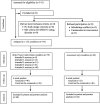A controlled trial of a dissonance-based eating disorders prevention program with Brazilian girls
- PMID: 32026167
- PMCID: PMC6967323
- DOI: 10.1186/s41155-019-0126-3
A controlled trial of a dissonance-based eating disorders prevention program with Brazilian girls
Abstract
Background: Given that most young women with eating disorders do not receive treatment, implementing effective prevention programs is a public health priority. The Body Project is a group-based eating disorder prevention program with evidence of both efficacy and effectiveness. This trial evaluated the efficacy of this prevention program with Brazilian girls, as no published study has tested whether this intervention is culturally sensitive and efficacious with Latin-American adolescents.
Methods: Female students were allocated to a dissonance-based intervention (n = 40) or assessment-only (n = 22) condition. The intervention was a dissonance-based program, consisted of four group sessions aimed to reduce thin-ideal internalization. The sessions included verbal, written, and behavioral exercises. The intervention group was evaluated at pretest and posttest; assessment-only controls completed measures at parallel times.
Results: Compared to assessment-only controls, intervention participants showed a significantly greater reduction in body dissatisfaction, sociocultural influence of the media, depressive symptoms, negative affect, as well as significantly greater increases in body appreciation. There were no significant effects for disordered eating attitudes and eating disorder symptoms.
Conclusions: These results suggest that this dissonance-based eating disorder prevention program was culturally sensitive, or at least culturally adaptive, and efficacious with Brazilian female adolescents. Indeed, the average effect size was slightly larger than has been observed in the large efficacy trial of this prevention program and in recent meta-analytic reviews.
Trial registration: RBR-7prdf2 . Registered 13 August 2018 (retrospectively registered).
Keywords: Body dissatisfaction; Dissonance; Eating disorder; Prevention.
Conflict of interest statement
The authors declare that they have no competing interests.
References
-
- Alvarenga MS, Dunker KLL, Philippi ST, Scagliusi FB. Influência da mídia em universitárias brasileiras de diferentes regiões. Jornal Brasileiro de Psiquiatria. 2010;59(2):111–118. doi: 10.1590/S0047-20852010000200006. - DOI
-
- Alves E, Vasconcelos FAG, Calvo MCM, Neves J. Prevalência de sintomas de anorexia nervosa e insatisfação com a Imagem Corporal em adolescentes do sexo feminino do município de Florianópolis, Santa Catarina, Brasil. Cadernos de Saúde Pública. 2008;24:503–512. doi: 10.1590/s0102-311x2008000300004. - DOI - PubMed
-
- Amaral ACS, Conti MA, Filgueiras JFF, Ferreira MEC. Qualidades Psicométricas do Questionário de Atitudes Socioculturais em relação à aparência-3 (SATAQ-3) para adolescentes. Psicologia: Teoria e Pesquisa. 2015;31(4):471–479. doi: 10.1590/0102-37722015042419471479. - DOI
LinkOut - more resources
Full Text Sources
Medical

